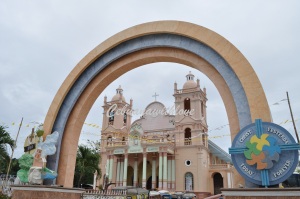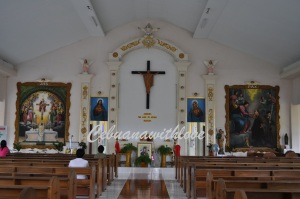Cebu City or Dakbayan sa Sugbu in Cebuano is also known as the Queen City of the South. Here, we will visit some churches and shrine in the northern part of Cebu. On myvacation in 2010, I had the chance to join Photographer’s Club of Cebu in their North Safari Photo shoot on April 17, 2010 .
Sto. Thomas de Villanueva Parish (Danao City Church) Established in 1595
Constructed in 1755 by Fr. Manuel de Santa Barbara, this church was made up of materials from sugar cane and rocks from the sea. In the 1800’s the crucero of the church was built . During the World War II in 1942, a fire partial gutted the building including some religious items and other important materials. Only the solid stones from the original construction of the church were spared from the fire. It was reconstructed in 1946. In 1981, another renovation of the building was made, this time almost a complete overhaul was done and only 30% of the original structure was preserved. The renovation was completed in 1985.

Facts about the famous bells of Sto. Tomas De Villanueva Parish:
They named the bells according to saints. The San Alipio bell, cast in 1845 and weighing 45 kilos, is the oldest. Two others, cast in 1917 were added and these were the Villanueva bell (630 kilos) and the Sagrado Corazon bell (249 kilos).
St. Benedict’s Monastery is home of the Benedictine monks and one of the tourist attractions inthe mountain side of Corte, Carmen, Cebu.
I doze off on the bus everytime we jumped in as we started the day very early, call time was at 4 am, so was very sleepy. When we alighted the bus, I was amazed by the serenity and tranquility of the place. I felt so much peace inside of me and engrossed in taking pictures that I did not bother on taking pictures of the models we have with us but of the place only.
After few days, I went back to this place with my family.
One of the famous attraction in Carmen is the famous bat cave facing the church of St. Benedict. Millions of rice-bats come out and can be seen together from this cave in the in evening (we arrived almost 6 pm with my family).



 Truly a Mother Nature’s beauty, this monastery is located in a panoramic natural landscape surrounded by high hills and creeks.
Truly a Mother Nature’s beauty, this monastery is located in a panoramic natural landscape surrounded by high hills and creeks.
This is the rosary center of the monastery. A big building almost like the church and it contains 20 life-size paintings of the Mysteries of the Holy Rosary.
As per history, St. Benedict’s Monastery, has St. Benedict, the great father and founder of monasticism, as it’s Patron Saint. The monastery started with very humble and pure origins. Three monks of South Indian origin were sent from Rome by the Abbot General Rt. Dev. Andrea Pantaloni, OSB to begin a monastery in the Central Visayas of the Philippines,particularly in Carmen, Cebu. The three monks from Kerala, India are: Rev. Frs. Thomas Thekkumthottam OSB, Bernard Devasia Kallakavunkal OSB and Joseph John Manjadyil OSB. On February 10, 1999, which is the feast day of St. Scholastica, the twin sister of St. Benedict, the monks started their journey.
A huge Sto. Nino, in cement was also built near the church. This Sto. Nino is a twelve feet statue on a twelve feet base and is known to be the biggest in the Philippines. This attracts pilgrims to visit this place especially those devotees of St. Nino. At far left of the picture is the monastery of the monks.
Next stop was the Shrine of St. Vincent Ferrer in Bogo, Cebu.


Bogo, Cebu is where we’ll find the Shrine of San Vicente de Ferrer, established as a Parish on May 31, 1850. The church was named in honor of the parish’s patron saint, St. Vincent de Ferrer. It’s old church is described as having walls of tabique pampango, posts of wood and a roof of thatch cogon is located near the town plaza. The present church of Bogo was built in the post-war era.

A relic of St. Vincent de Ferrer is kept safe inside the church.
The signage leading to the Shrine of the Miraculous Medal.
This is the Shrine of Our Lady or Miraculous Medal. On the highway, one can see the shrine above the mountain during day time with its hand stretched-wide open, such a breath-taking view.
 At first, I was so hesitant to join the group in climbing up the hill as I was already tired and wanted to stay in the bus but thinking twice, I thought I might not be able to come back again so might as well grab the chance.
At first, I was so hesitant to join the group in climbing up the hill as I was already tired and wanted to stay in the bus but thinking twice, I thought I might not be able to come back again so might as well grab the chance.
On foot, one will have to go climb 163 steps before you reach the top of the hill where the statue and chapel of the Lady of the Miraculous Medal is nestled. It was a tiring climb but worth the steps. Cool wind blowing and caressing the face not to mention the breath-taking view is worth the climb. Took some time to pray and meditate at the chapel.
The altar of the chapel. A large number of devotees and pilgrims of the Blessed Virgin Mary flock to this hill-side during the Holy week.
Until then, see you on the part 2 of churches, monasteries and shrines in Cebu.

















Pingback: Archdiocesan Shrine of Saint Vincent Ferrer/ Simbahan ni San Vicente Ferrer/ Church of Bogo (Bogo, Cebu) « Pinoy Churches
anyone know’s the masses schedule?